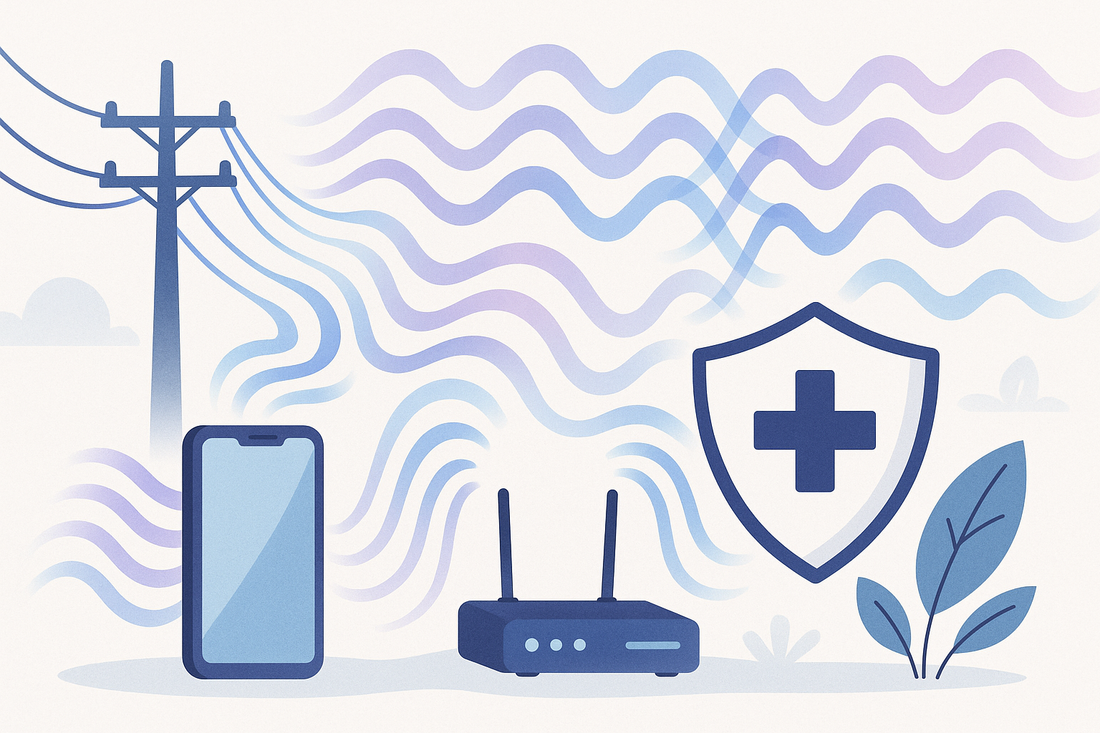
What Are EMFs and Why Should You Care?
Share
In our increasingly connected world, electromagnetic fields (EMFs) are everywhere — from your cell phone and Wi-Fi router to your laptop and even smart appliances. But what exactly are EMFs, and what impact might they have on your health?
Let’s break it down.
What Are EMFs?
Electromagnetic fields are invisible areas of energy, often referred to as radiation, associated with the use of electrical power and various forms of natural and man-made lighting.
There are two main types of EMFs:
- Low-frequency EMFs – From power lines, electrical wiring, and household appliances.
- High-frequency EMFs – From wireless devices like cell phones, Wi-Fi routers, Bluetooth devices, and 5G towers.
While low-frequency EMFs have been around for over a century, the intensity and constant exposure to high-frequency EMFs is relatively new — and growing rapidly with our dependence on wireless technology.
Health Concerns Around EMF Exposure
Research is still evolving, but growing evidence suggests prolonged EMF exposure may have biological effects.
1. Oxidative Stress and Cellular Damage
Studies have shown that EMF exposure can lead to oxidative stress — an imbalance of free radicals and antioxidants in the body, which may damage cells and DNA.
📚 Reference: Yakymenko I, et al. “Oxidative mechanisms of biological activity of low-intensity radiofrequency radiation.” Electromagnetic Biology and Medicine, 2016.
2. Neurological and Cognitive Effects
EMFs may interfere with brain activity, leading to symptoms like brain fog, headaches, anxiety, and sleep disturbances. Some studies show changes in EEG patterns and disrupted melatonin production from EMF exposure.
📚 Reference: Belyaev I. “Biological effects from exposure to electromagnetic fields: current debates and experimental research.” European Journal of Oncology Library, 2010.
3. Potential Cancer Risk
While research is ongoing, the World Health Organization’s International Agency for Research on Cancer (IARC)has classified radiofrequency EMFs as “possibly carcinogenic to humans” (Group 2B) due to links with certain types of brain tumors.
📚 Reference: IARC Monographs, Volume 102, “Non-Ionizing Radiation, Part 2: Radiofrequency Electromagnetic Fields,” WHO.
EMF Sensitivity and Everyday Symptoms
Some individuals report a condition called Electromagnetic Hypersensitivity (EHS). While not officially recognized as a medical diagnosis, symptoms may include:
- Fatigue
- Difficulty concentrating
- Sleep issues
- Tinnitus
- Dizziness
- Skin irritation
Even if you don’t feel immediate symptoms, EMF exposure accumulates over time, making prevention and protectionincreasingly important.
How to Reduce EMF Exposure
While it’s nearly impossible to avoid EMFs entirely, here are a few ways to reduce exposure:
- Use airplane mode when not using your phone
- Keep devices away from your body
- Turn off Wi-Fi at night
- Hardwire your internet where possible
- Use EMF-protection products for personal and home use
Why Hedron EMF Protection Works
Hedron EMF Protection offers a range of scientifically-backed products designed to harmonize and neutralize the effects of EMFs on the body. Unlike shielding, which blocks EMFs (often inconsistently), Hedron products transform harmful frequencies into more biologically friendly signals using natural minerals like shungite and proprietary technology that’s been validated in lab testing.
From wearable pendants to home and device harmonizers, Hedron supports your body’s ability to function optimally — even in today’s wireless world.
